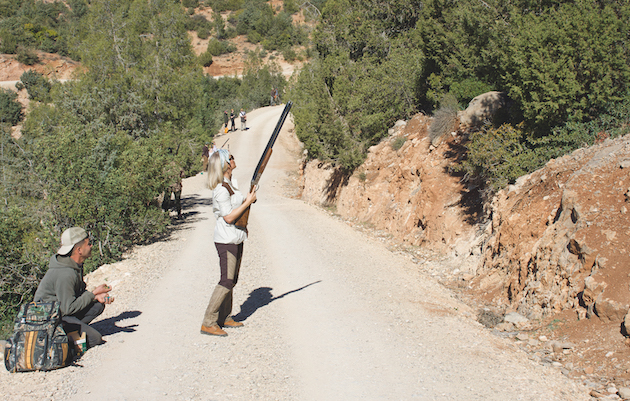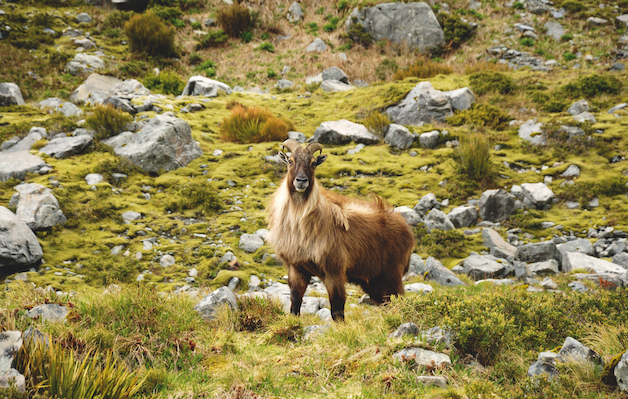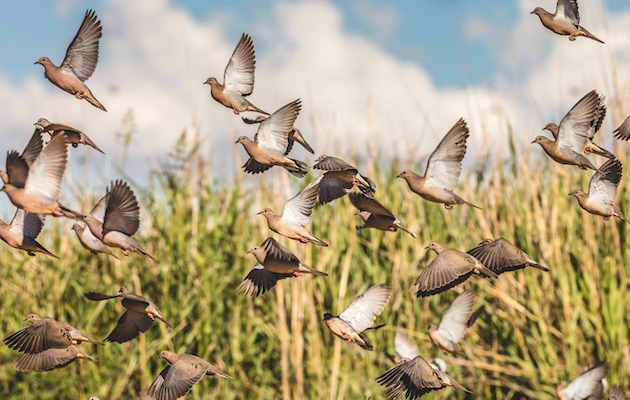If you feel like it is time to escape, Sarah Fitzpatrick shares the perfect list of overseas destinations to help you plan your next shooting trip
Sarah Fitzpatrick rounds up six of the best places to go shooting abroad — from rock pigeons in South Africa to bobwhite quail in the USA.
Since it first appeared in 1879, the round action has been produced by just three Scottish gunmakers. It has lost none of its appeal over the years, says Donald Dallas. Find out more about it.
Don’t be distracted by the decoration – when choosing a new shotgun, barrel construction should be a top priority, too, says Luke Davison.
6 OF THE BEST PLACES TO GO SHOOTING ABROAD
The British sportsman is truly blessed. Hunters travel across the globe to enjoy our rich sporting heritage and experience the challenges and delights that our many quarry species have to offer. But while the variety and quality of sport available here is astonishing, there’s still nothing like a busman’s holiday for game. So if your gun is getting itchy feet we would like to make some suggestions that it would be worth travelling for. Grab your passport and upgrade the roving syndicate to intercontinental.
1. Doves in Argentina

Action-packed shooting and luxurious lodges go without saying in Cordoba. The doves exist here in such quantities that they are an agricultural pest but create a once-in-a-lifetime experience for Guns. Before you have time to curse a miss you can be pulling the trigger again. The huge volume and variety presented by doves here mean you can pretend you are shooting steeple-high pheasants, partridges, even grouse. Guns are often able to combine a trip with some fun fishing, too.
Field columnist Serena Cross gets straight to the point, as you’d expect from the founder of shooting and lifestyle consultancy Phoenix Sporting: “The sheer volume of birds is staggering and my advice would be to get in training with light loads and several thousand clays before embarking on this adventure. Wear a lightweight vest with a thick recoil pad but, failing this, a magnum of Malbec serves as a useful anaesthetic for a bruised shoulder.”
Cross visited Los Ombues in Argentina but there are plenty of options. William Powell Sporting will fly Guns by Cessna from Buenos Aires to purpose-built Guyascate Lodge, where the air conditioning, swimming pool, wine cellar and private chef will help them recharge between shoots.
2. Cape Buffalo in Africa

A buffalo represents the pinnacle of sporting achievement for many hunters – those who are brave enough. “I think it is the danger that buffalo hunting puts on the table that is its greatest attraction. There are more than a few professional hunters who have been killed or badly injured by buffalo,” says Graham Hingeston of HHK Safaris. “A wounded buffalo becomes extremely aggressive and very clever, often circling around and lying in wait for the hunters. There is always an adrenaline rush following buffalo (wounded or not) into thick bush and you have to have every sense alert.” However, he is keen to stress the importance and excitement of the fieldcraft involved, too. “Watching local trackers follow the spoor of a ‘dagga’ boy through long grass or over rocky terrain is an experience in itself.”
Buffalo are available across the continent but, as Hingeston explains, “Zimbabwe has always been the one country in Africa that offers true wilderness and free-range hunting for reasonable prices, and this holds true today. For a first-time hunter, Zimbabwe is a great choice. It’s affordable and every bit as good as higher-priced countries such as Botswana, Tanzania and Zambia.”
The main thing is to book a truly free-range safari and take comfortable, worn-in and supportive ankle boots. “Bring a spare pair as well, just in case,” Hingeston adds. “And bring enough gun – a big old buffalo bull can weigh up to 2,000lb of solid muscle and bone. In Zimbabwe, the minimum calibre, by law, you are allowed to use is a .375. Personally, I recommend a bigger calibre, such as .416 Rigby, and my preference in a bolt-action rifle is the .458 Lott, which I believe is the ultimate big game bullet and matches the .500 calibre double rifles such as the .470. Talk to your safari operator and prepare properly before departure, it’s the trip of a lifetime.
3. Barbary Partridge in Morocco

Just a 3½-hour flight away, Morocco is close to home but still worlds away. Atlas Sporting manages 70,000 hectares in the Azilal Province that holds a range of native game. Its sporting holidays include unfenced driven boar shooting, migratory quail over pointers and Barbary partridges, which are driven to lines of five to 10 Guns. Much like red-legs but with wings shaped more like grouse, the Barbary partridge is a “fierce flyer”, according to Matthew Hollington of Atlas Sporting. They are “slightly larger, but with a similar ‘get up and go’ to the red-legged partridge, making it an exciting quarry for any game shot, especially when pushed off the high Atlas mountain cliffs.”
The sounds of approaching beaters and presence of a loader might be familiar but the environment sets this experience apart. Standing at your peg 1,600 metres above sea level must be heady and “the vast, snow-capped mountain range lies as a backdrop, a reminder that you are in a truly wild part of the world,” enthuses Hollington.
The sun-drenched terrain is rugged with clusters of juniper trees and stands of cedar surrounding the Guns. Birds, flushed from dense cover, might soar overhead, making a dash for the opposing hillside, or curl off high to follow the contours of the valley below, making challenging driven shots and there is the chance to make up for misses going away, too. The season runs from 1 October to 31 March, so it’s a great way to extend your season. Flights are to Marrakech or Casablanca and accommodation is at the five-star Widiane hotel, with spa and access to watersports.
4. Rock Pigeons in South Africa

The enduring appeal of Africa to travellers and hunters is undisputed, and the convenience of being a neighbouring time zone and a favourable exchange rate make wing shooting in South Africa an easy introduction to an African sporting adventure. EJ Churchill has been taking Guns to the Bloemfontein region for years and Rob Fenwick insists that “we have now got it perfect, with great hospitality, good food and local wines. Also, really good local people who know what the UK market needs.”
Rock pigeons are described as like a cross between our pigeons and grouse, so make for exciting shooting; expect to use between 250 and 750 cartridges a day. Guns are placed to intercept flight paths as the birds come and go from their feeding grounds, including fields of sunflowers (bloemfontein means ‘fountain of flowers’ in Afrikaans).
After an overnight flight, guests are whisked from the airport to the lodges an hour away. This leaves time to shower, eat and be shooting about midday “fresh as a daisy”, according to Fenwick. One would need to be as the birds are sharp. “They fly fast and can turn and accelerate instantly,” Fenwick warns. With trips from March to May, you will hopefully be well tuned following a busy shooting season in Blighty.
5. Himalayan Tahr in New Zealand

These ungulates lead an extreme existence. Listed as ‘near threatened’ in their native lands, life in New Zealand suited them and they are now classified as a ‘noxious animal’ and their control is deemed essential. Introduced by the Duke of Bedford in 1904 around Mount Cook, tahr have become a sought-after addition to the gamebook. A tahr might be considered to have a good head with horns 12in or more, and when their thick and long winter cape comes in they are an impressive and lionine sight. At the altitudes tahr enjoy, it pays to be fit “and have a head for heights”, says David Darling of Hunting and Fishing New Zealand.
Hunting in New Zealand is easily accessible and there are Department of Conservation (DOC) Huts where anyone can stay. However, visiting Guns are advised to pay for a guided trip on private land as it “is easier to get to and there is less pressure” on the animals, according to Scott Kunac, chairman of Hunting and Fishing New Zealand.
Croc Adams runs Southern Mountain Adventures from Glen Lyon station, hunting tahr over a 100,000-acre block around his lodge. He is adamant his guests have “the best view in the world”. The sport is good from March to October but tahr lose their capes in the summer and can be snow damaged over winter, so for the best-looking beasts book May to August.
6. Bobwhite Quail in the USA

Part of the New World quail family, the bobwhite is a much-loved gamebird in the south-east of the USA. For a Handful of Feathers by Guy de la Valdene, published in 1995, describes this sportsman and naturalist’s love affair with the bird. He bought 800 acres near Tallahassee in order to raise them. Today, they are hunted with full romance and nostalgia on plantations such as Pine Hill in Georgia.
Multiple Macnabber and experienced quail shot Joseph Thompson explained that the shooting of truly wild birds is restricted to private plantations, and generally by invitation only: “Wild birds are unbelievably fast. When the dogs point the birds are invisible to the shooters. When the birds are flushed under the shooter’s feet it is always surprising and sounds like 30 little blenders being turned on all at once.”
For those of us not lucky enough to receive an invitation, there are commercial ‘early release’ shoots, where birds are put down and keepered, with feeding and predator management. “This is excellent shooting,” Thompson confirms. “Those who have not shot truly wild birds will mistake them for wild.”
A day at Pine Hill Plantation will involve a mule-drawn wagon or horse ride to the hunt, with each covey addressed by two shooters, on a rotation. The season runs from October to March and while described as a ‘vintage’ experience, it certainly retains its appeal.
SHOOTING ABROAD: BOOK YOUR BREAK
William Powell Sporting (Doves)
Price $19,560 per day for exclusive and all-inclusive use of the lodge and shooting; single Gun $5,868 per day
Tel 01295 661033
williampowellsporting.co.uk
Los Ombues (doves)
Price $2,100 per person, includes three full days of hunting plus a fourth day free). Excludes flights but there is transport from Buenos Aires for groups of six or more
Email info@losombues.com
losombues.com
Roxtons (Doves)
Price from $850 per Gun per day, at Guayascate Lodge
Tel 01488 689788
roxtons.com
HHK Safaris (Buffalo)
Price Zimbabwe $13,500-$15,000 (seven-day safari); $16,000-$21,000 (10-day safari), including government licences, excluding flights and local transfers
Email graham@hhksafaris.com
hhksafaris.com
Atlas Sporting (Barbary partridge)
Price from £1,300 per Gun for a 100-bird day, including two nights’ accommodation, all inclusive; excluding flights. Back-to-back days are possible, for up to 600 birds
Tel 01444 717397
atlassporting.com
EJ Churchill (Rock pigeons)
Price approximately £2,000-£2,500 per Gun, excluding flights
Tel 01494 883227
ejchurchill.com
Southern Mountain Adventures (Tahr)
Price $8,500 for five days, includes transfers, accommodation and food
Tel +64 27 208 9053 southernmountainadventures.com
Pine Hill Plantation (Bobwhite quail)
Price $1,950 per person per day (for a hunt group of four staying in a private lodge with single occupancy)
Email reservations@pinehillplantation.com





